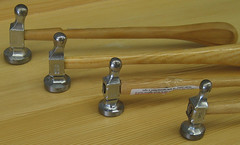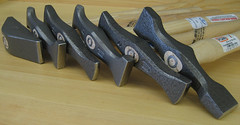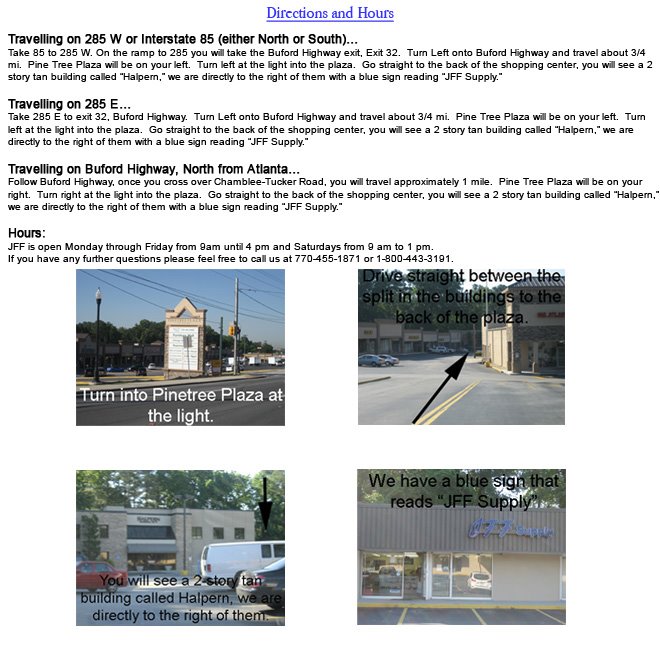Tool of the Month:
Hammers & Mallets
Anyone who has talked to me in JFF knows how much I LOVE hammers. When I first started making jewelry, I tried out different hammers and played with the different effects they made on metal. But I didn’t know the difference from a steel embossing hammer and a cross peen hammer. This article will hopefully help to describe the different hammers and explain what each does. And maybe even help with purchasing your first, second or twentieth hammer!
When shopping for a new hammer it helps to know what the desired effect you are looking for. Hammers and mallets are made from different materials and come in various shapes. The material will determine whether you are
1. hardening the metal without stretching or thinning it out.
2. moving the metal with the intent to change the thickness and shape.
The different shape and head sizes of hammers will determine the direction the metal will move and stretch and how quickly this will occur.
Before I go into detail about the different kind of hammers, I want to define a few words that will be used throughout.
Peening: hammering with the purpose of spreading the surface of the metal. Also hardening the surface in the process.
Sinking: also known as embossing, doming, dishing or dapping. This process forces silver down into a surface that is curved, cupped, domed or stretched.
Raising: sheet metal is formed into a bowl or other hollow object by repeated sequences of hammering on a stake, stretching the metal over the stake to create the desired convex shape.
Planishing: after a piece of metal has been roughly formed by techniques such as sinking or raising, the surface will have irregular indentations and bumps. To remove these imperfections, the piece is hammered between a flat or slightly curved hammer and a steel block or planishing stake.
Cross Peen hammer: this is a category of hammers. Many of the hammers I will describe have a cross peen face, meaning it has a wedge-shaped surface that is perpendicular to the handle of the hammer.
Mallets
Mallets are great for shaping and forming metal around a mandrel without stretching or leaving behind hammer marks on the surface of the metal. This is possible because they are made of a softer material than the metal you are hammering. The face of a mallet will have a flat or slightly convex striking surface on both sides.

Plastic & Rawhide Mallets
Traditionally, a mallet is made of wood, but have since been replaced by the longer lasting and somewhat heavier plastic and rawhide mallets. A rawhide or plastic mallet is an endlessly useful hammer and is essential in your arsenal of jewelry tools. The plastic mallet is $15.45 and the rawhide mallet is $18.45.
 Horn & Nylon Forming Mallet
Horn & Nylon Forming MalletAnother traditional mallet was made of the solid end of a cow’s horn. The natural conical shape of the horn was great for general forming with the larger flat end and more specific shaping and bending with the blunt point on the other end. As you can imagine obtaining a horn mallet is rather difficult these days, but plastic versions are more readily available today. The nylon forming mallet has a round, slightly convex face for normal striking on one end, the other face is a cross peen. This replaces a steel cross peen hammer and is great for raising and sinking when stretching and marking the metal is not the desired effect. The nylon forming mallet is $10.50.
Dead Blow Mallet

Dead blow mallets have become a popular in jewelry-making in the past few years. The head of these hammers are commonly hollow and filled with sand or shot, which absorbs the impact of a strike, reducing the bounce-back. This also produces a stronger, more powerful blow that will move the metal much faster. The mallet is constructed of polyurethane, which will minimize marring and marking on the surface of the metal. Dead blow mallets come in 10oz and 18oz weights, priced at $23.50 and $28.50 respectively.
Brass Mallet
Striking a steel hammer on a steel tool will eventually balloon out the top of the tool, which is not usually a desired effect when you spend $100+ on the tool. Therefore, a brass mallet is really the ticket. The brass is softer than the steel and will not damage the tool. When using a brass mallet for this task a 1-2 lb weight is good.
Brass mallets are also used by repair jewelers to shape and resize a ring, typically when the plastic or rawhide mallet is not enough. The brass will slightly mark the metal (less than a steel hammer) while stretching and forming quicker than the plastic or rawhide mallets. These hammers are much lighter than the ones mentioned above and are priced at $7.10.
Steel Hammers
There are a variety of different size, shape, and weight of steel hammers. Steel hammers are a valuable tool in jewelry-making, the quality, weight and shape of the hammer will determine what it is best suited for. Care of your steel hammers is also imperative.
Good quality steel hammers are made of hardened tool steel, making them an easy target for rust. While stainless steel seems like the obvious fix because it doesn’t rust, the alloys that make stainless create a softer steel than tool steel. Therefore, taking care of your hammers by oiling them and protecting them from moisture while not in use is very important. To store my hammers, I wipe oil on the faces of the hammer and store them in old socks.
If you decide to use a steel hammer to strike your steel tools, keep those hammers separate from the hammers that come in direct contact with your metal. Steel is much stronger than the metals jewelers use (silver, gold, brass, copper, etc), transferring any pits, marks, or dull spots that are on the surface hammer to the metal. Keeping your steel hammers that come into contact with your metal polished and smooth will leave you with less clean up.
 Ball Peen Hammer
Ball Peen HammerA jeweler’s ball peen hammer looks just like any other hardware store ball peen hammer, however it’s usually slightly smaller. These hammers have one flat, planishing end and one round, sinking end. Ball peen hammers are used for flattening, shaping or removing dents. Ball peen hammers come in two different quality ranges, the economical chrome plated hammers range in price from $4-$8, while the solid steel Vaughan hammers, pictured to the left are $16.75 for 4oz and $17.75 for 8oz.
Chasing Hammer
Chasing hammers were originally made for chasing and repoussé. The hammer has one large smooth, flat, planishing face that is used for striking the chasing tool, and a small round, embossing end for riveting or peening. Chasing hammers offer two different types of handles, a rounded-style or pistol-style handle. The difference in handles is more essential in chasing and repoussé work, as the ratio of weight of the hammer head to the handle is important for balance.
 The idea being that while chasing, the hammer should make an easy rhythm or bounce with the chasing tool, the wrist working as a pivot point creating little to no added work to the jeweler. The rounded handle balances smaller hammer heads, where as the pistol style handle balances a larger head. These German chasing hammers are priced between $33 and $50.
The idea being that while chasing, the hammer should make an easy rhythm or bounce with the chasing tool, the wrist working as a pivot point creating little to no added work to the jeweler. The rounded handle balances smaller hammer heads, where as the pistol style handle balances a larger head. These German chasing hammers are priced between $33 and $50.Lightweight, inexpensive chasing hammers have become a popular first hammer for many beginner jewelers. The slightly convex side is great for light planishing and flattening, while the ball side is a perfect choice for creating a hammered texture. These hammers are made of chrome plated steel and cannot be polished when dents appear, however, cared for properly, these hammers should last a couple years. These hammers are about $14.
 Riveting Hammer
Riveting HammerThis lightweight steel hammer is designed for spreading rivet heads but has countless other uses. One end is a thin cross peen used for riveting, while the flat, planishing end is for leveling the rivet and other general hammering tasks. Riveting hammers range in price from $5 - $20.
Goldsmith Hammer

This hammer is used for small scale forging and shaping. It features a round, slightly crowned planishing end for general purpose use. The opposite end is a cross peen, perfect for spreading rivet heads, forming and shaping. This hammer is also great for striking steel stamps. I, personally, love this hammer. So much so, I have two; one for stamping steel stamps and the other for small planishing and forming projects. The solid tool steel German goldsmith hammer is $33.50.
Silversmith Hammer
The Silversmith style hammers JFF carries are German-made Picard hammers. Picard hammers have superior forged steel heads for high performance and durability, all fitted with hickory handles. They are specially designed for all types of planishing, forging, raising and embossing. Widely used by jewelers and metalsmiths. Many times silversmithing hammers will need to be modified for your individual use. It is highly unusual to purchase a steel hammer and it be exactly what you need without any alteration. These hammers range in price from $43.75 to $57.75.
- Planishing Hammers
The planishing hammer has a flat or slightly domed face. This hammer is great for not only smoothing hammer marks left from raising and sinking, it also flattens wire and sheet leaving little to no hammer marks behind. The face of a planishing hammer will stretch the metal in all directions.
- Raising Hammers
Raising hammers are distinguished as having a rounded, polished cross peen. The corners are rounded to prevent marring the metal. Raising hammers are most commonly used when raising a bowl or other vessels.
Forging hammers also have a polished cross peen, however, the face is slightly squarer and sharper. The sharp, rectangular shape of the face stretches the metal in one direction. Forging hammers are used when fold-forming, synclastic and anticlastic forming. This hammer is also popular for leaving a line texture.
- Sinking or Embossing Hammers
These hammers are similar in size and weight to a planishing hammer, but has round, severely domed faces, think of the ball of a ball peen hammer. These hammers force silver down into a surface that is curved, cupped, domed or stretched. Embossing hammers are also used in repoussé work.
Texturing Hammer
Texturing hammers are the exception to the smooth, polished face rule for steel hammers. These hammers will have rounded divots, lines, and other specialty designs ground into the face of the hammer. Texture hammers are either purchased with the texture already in them, or are made by the jeweler for a specific job. The texture hammers JFF carries are double sided and are $19.95 each.



prices are subject to change without notice.
Please note: in the time since the article was written we carry Fretz Hammers and 1 lb. Brass Mallets




No comments:
Post a Comment